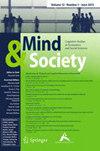环境与人类健康:超越学科禁锢
Q1 Arts and Humanities
引用次数: 0
摘要
人类健康是生活方式、遗传、心理和其他因素相互作用的结果。此外,人类还暴露在众多影响身心健康的环境因素中。在本研究中,我们将从广义上理解环境暴露对身心健康的影响。环境对身心健康有直接和间接的影响。高层住宅和其他建筑不利于人们的心理健康。过度拥挤的住宅、这些高密度区域和嘈杂的外部噪声源会增加心理压力,并可能导致身心失调。带有刺激性气味的空气污染物会扩大负面影响,环境污染物还与行为紊乱有关。缺乏充足的日照与忧郁倾向和抑郁症状的增加有着可靠的联系。因此,环境因素继续对身心健康产生负面影响。环境有可能鼓励或抑制人与人之间的互动。与此同时,个人的控制能力、社会支持、人际关系以及紧张和疲劳的恢复都可能受到建筑环境各个方面和特性的影响。即使在 COVID-19 大流行期间,在家工作已成为一种普遍现象,环境因素对个人的健康结果仍有重大影响。因此,本文试图揭示以多种方式影响用户身心健康的环境因素,以及如何通过改善有形环境来减轻压力、提高安全性和改善效果。本文章由计算机程序翻译,如有差异,请以英文原文为准。
Environment and Human Health: Beyond Disciplinary Confinement
The human health results from the interplay of lifestyle, genetic, psychological, and other factors. In addition, humans are exposed to numerous environmental factors that affect their physical and mental health. In the present piece of work, the impact of environmental exposure on mental and physical health is understood in the broadest sense. The environment has direct and indirect effects on mental and physical health. High-rise housing and other constructions are detrimental to the psychological wellbeing of people. Residential overcrowding, these high-density areas, and noisy exterior noise sources increase psychological distress and may contribute to the development of mental and physical disorders. Air pollutants with a pungent odor amplify negative effects, and environmental pollutants have also been linked to behavioral disturbances. Lack of adequate daylight is reliably associated with melancholic dispositions and increased depressive symptoms. Consequently, environmental factors continue to negatively impact both mental and physical health. The environment has the potential to encourage or inhibit human interaction. Along with this, individuals’ personal control, social support, relationships, and restoration from tension and fatigue may all be affected by various aspects and properties of the built environment. Even during the COVID-19 pandemic, when work from home had become commonplace, environmental factors had a significant impact on the health outcomes of individuals. Hence, this article is trying to shed light on the environmental factors that affect the physical and mental health of its users in more than one way and what can be done to make it less stressful, safer, and better by improving the tangible environment.
求助全文
通过发布文献求助,成功后即可免费获取论文全文。
去求助
来源期刊

Mind and Society
Arts and Humanities-Philosophy
CiteScore
2.30
自引率
0.00%
发文量
5
期刊介绍:
Mind & Society is a journal for ideas, explorations, investigations and discussions on the interaction between the human mind and the societal environments. Scholars from all fields of inquiry who entertain and examine various aspects of these interactions are warmly invited to submit their work. The journal welcomes case studies, theoretical analysis and modeling, data analysis and reports (quantitative and qualitative) that can offer insight into existing frameworks or offer views and reason for the promise of new directions for the study of interaction between the mind and the society. The potential contributors are particularly encouraged to carefully consider the impact of their work on societal functions in private and public sectors, and to dedicate part of their discussion to an explicit clarification of such, existing or potential, implications.Officially cited as: Mind Soc
 求助内容:
求助内容: 应助结果提醒方式:
应助结果提醒方式:


